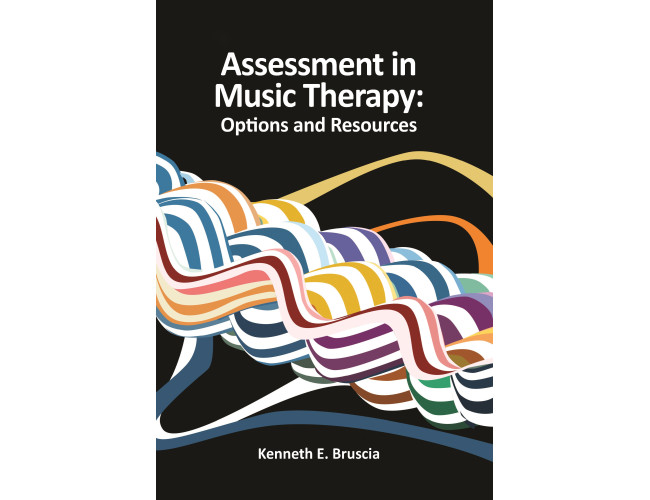Assessment in Music Therapy: Options & Resources
- Author: Bruscia, Kenneth E.
- ISBN: 9781945411632
- E-ISBN: 9781945411816
Table of Contents
Unit One: Overview
Chapter 1: INTRODUCTION
Definitions and Distinctions
Rationale for Using Music
The Four Main Methods
Levels of Musical Data
Health Domains
Objectives of Assessment
References
Chapter 2: THE ASSESSMENT PROCESS
Pre-Session Assessment
Setting Assessment Objectives
Selection of Assessment Protocol
Data Analysis
Clinical Interpretations
References
Chapter 3: THERAPIST AS LISTENER
Perspective vs. Attitude
Notational Listening
Open Music Listening
Focused Music Listening
Holistic Music Listening
Open and Focused Clinical Listening
Empathic Listening
Cyclic Listening
Intersubjective Listening
Subjective Listening
Self-Listening
Altered State Listening
Mindful Listening
Ambient Listening
Fluid Listening
Integrative Listening
A Synthesis
References
Chapter 4: INDICATIONS AND CONTRAINDICATIONS
Indications
Therapeutic Risks and Contraindications
References
Chapter 5: ETHICAL AND DIVERSITY CONSIDERATIONS
Ethical Considerations
Diversity Considerations
Intersectionality
Differences in Worldviews
Conclusions
References
Chapter 6: PARADIGMS AND INTEGRITY
Paradigms
Integrity Standards in the Objectivist Paradigm
Integrity Standards in the Interpretivist Paradigm
Integrity Standards for Music Therapy Assessment
References
Chapter 7: DIFFERENT TYPES OF ASSESSMENT
Types of Assessment
Rationale for the Various Types
Implications
References
Chapter 8: WRITING ASSESSMENT REPORTS
Recommendations for Full Reports
Recommendations for Progress Notes
Final Note
Unit Two: The Four Musical Methods of Assessment
Chapter 9: LISTENING METHODS
Rationale
Existing Assessments
References
Chapter10: RE-CREATIVE METHODS
Rationale
Existing Assessments
References
Chapter 11: IMPROVISATIONAL METHODS
Rationale
Existing Assessments
References
Chapter 12: COMPOSITIONAL METHOD: SONGWRITING
Rationale
Procedural Considerations
Existing Assessments
References
Unit Three: The Biographical, the Medical or Physical, and the Behavioral Domains
Chapter 13: THE BIOGRAPHICAL DOMAIN
Data Collection
Existing Assessments
References
Chapter 14: THE MEDICAL OR PHYSICAL DOMAIN
Background Information
Brain Activity
Existing Assessments
References
Chapter 15: THE BEHAVIORAL DOMAIN
Procedural Considerations
Tracking Targeted Behaviors
Tracking Interactive Behavior
Behavior Inventories
Behavior Streams
Existing Assessments
References
Unit Four: The Skill Domain
Chapter 16: VOICE PRODUCTION AND CONTROL
Overview
Vocal Production
Vocal Control
Methods of Appraisal
Diagnostic Links
Stages of Development
References
Chapter 17: VOCAL-TONAL SKILLS
Overview
Pitch Perception
Pitch Imitation
Interval Perception
Interval Imitation
Contour Perception
Melody Perception
Melody Conservation
Melody Recognition
Melody Imitation
Maintenance of Tonality
Harmony Perception and Production
Song Recognition
Singing Songs
Stages of Development
Existing Assessments
References
Chapter 18: INSTRUMENTAL SKILLS
Tasks
Criteria for Assessment
Unpitched Percussive Instruments
Tone Bar Instruments
Instrumental Tonal Skills
Stages of Development
Existing Assessments
References
Chapter 19: IMPROVISING SKILLS
Intentionality
Patterning
Self-Regulated Expression
Integration
Variability
Self-Monitoring
Stages of Development
References
Chapter 20: PULSE-RELATED SKILLS
Overview
Definitions
Indications and Contraindications
Duration Skills
Pulse Perception
Pulse Production
Pulse/Tempo Maintenance
Spontaneous Tempo
Tempo Perception
Producing Different Tempos
Perceiving Meter
Meter Production
Stages of Development
Summary
Chapter 21: RHYTHM SKILLS
Significance
Duration Perception and Imitation
Number Perception and Imitation
Serial Order Perception
Rhythm Perception
Rhythm Imitation
Stages of Development
Existing Assessments
References
Chapter 22: SYNCHRONIZATION SKILLS
Overview
Variables
Assessment Options
Measurement and Evaluation
Diagnostic Links
Resources
Stages of Development
References
Chapter 23: TIMBRE AND VOLUME PERCEPTION SKILLS
Timbre Perception
Significance
Volume Perception
Existing Assessments
Developmental Stages
References
Chapter 24: GENERAL RECEPTIVE SKILLS
Definition of Music Aptitude
The Concept of Natural Musicality
Contraindications
Existing Assessments
Diagnostic Links
Stages of Development
References
Chapter 25: DATA ANALYSIS AND INTERPRETATION OF SKILL ASSESSMENTS
Descriptive Skill Assessment
Interpretive Skills Assessment
Diagnostic Assessment
Prescriptive Assessment
Evaluative Assessment
References
Unit Four: The Intrapersonal Domain
Chapter 26: ACTIVITY PREFERENCES
Main Variables
Diagnostic Links
Media Preferences
Existing Assessments
References
Chapter 27: LISTENING PREFERENCES
Musical Variables
Listener Variables
Healthy Uses of Music Listening
Unhealthy Uses of Music Listening
Personality
Circumstances
Mood
Body Variables
Relational Variables
Culture
Diagnostic Links
Existing Assessments
References
Chapter 28: INDIVIDUAL NONREFERENTIAL IMPROVISATION
Approach to Assessment
The Projective Hypothesis
Contraindications
Medium and Instrument Selection
Salience
Integration
Variability
Tension
Expressivity
Client Insights
References
Chapter 29: REFERENTIAL IMPROVISATION
Analytical Music Therapy (AMT)
Scheiby Assessment
The Integration of Image, Music, and Life
An Inner World Assessment
References
Chapter 30: GUIDED IMAGERY AND MUSIC (GIM)
Introduction
Intake Assessment
Assessments After Intake
Imagery Analysis
References
Chapter 31: SONGS AND SONG EXPERIENCES
Setting for the Song Experience
Types of Song Experiences
Music
Client Problems and Resources
Collecting Projective Data
Song Improvisations
Interpreting Song Projections
Client Insights
Existing Assessments
References
Unit Five: The Relational Domain
Chapter 32: CLIENT-THERAPIST IMPROVISATIONS:
Musical Analysis
Instrument Choice
Musical Readiness
Shared Auditory Images
Salience
Integration
Variability
Tension
Congruence
Autonomy
Existing Assessments
References
Chapter 33: SIGNIFICANT-OTHER IMPROVISATIONS
Focus
Preliminary Considerations
Modes of Communication
Role of the Therapist
Musical Analysis and Interpretation
Referential Improvisations
Client Insights
Existing Assessments
References
Chapter 34: INSTRUMENTAL GROUP IMPROVISATIONS
Approach to Assessment
Preliminary Considerations
Musical Analysis and Interpretation
Verbal Interactions
Client Insights
Existing Assessments
References
Chapter 35: GROUP SONGWRITING
Preliminary Considerations
Different Approaches
Contraindications
Client Readiness
Analyzing the Lyrics
Analyzing the Music and Lyrics
Group Dynamics
Performing the Song
Notating or Recording the Song
Reacting to the Song
Existing Assessments
References
Index

